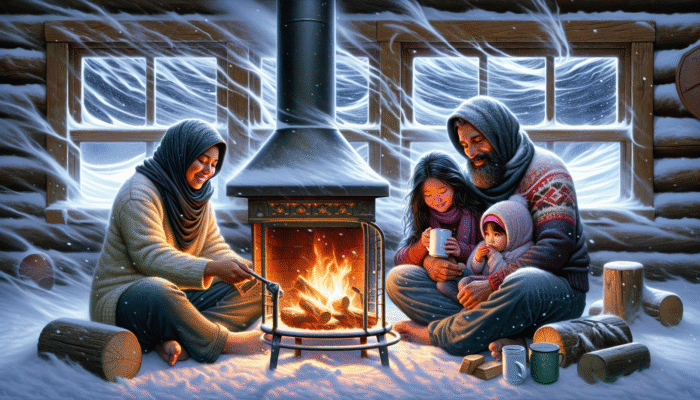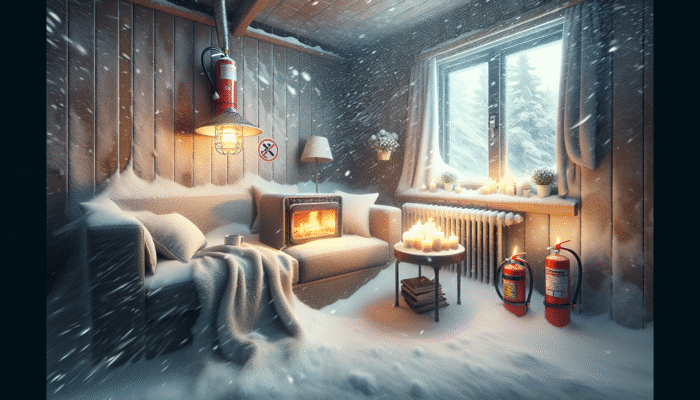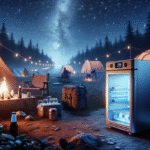Ultimate Guide to Effectively Preparing for Blizzard Survival
Crucial Supplies to Guarantee Your Readiness for Blizzard Conditions

Being thoroughly prepared for the brutal realities of a blizzard can be your most significant advantage in ensuring both safety and comfort. Stocking up on essential supplies stands as a pivotal measure that can make an immense impact during the storm. Start by evaluating your food needs; aim for at least three days' worth of non-perishable items to sustain you and your family. Incorporate a variety of nutritious and calorie-dense options such as canned goods, dried fruits, nuts, and energy bars. These selections not only boast an extensive shelf life but also deliver the necessary energy needed to keep you moving during challenging conditions. Furthermore, the importance of water cannot be emphasised enough; ensure that every member of your household has access to at least one gallon per day for drinking and sanitation purposes. Accumulating enough water is vital for survival in a blizzard scenario.
Beyond food and water, possessing a well-stocked first-aid kit is absolutely essential for your safety. This kit should comprise necessary items such as bandages, antiseptics, and any personal medications you may require during this critical period. If you have pets, don't forget to include sufficient food and supplies for them as well. In addition, gather crucial items like batteries, flashlights, and a manual can opener, which will prove invaluable when you need them most. For individuals residing in regions that frequently endure severe winter conditions, investing in a portable generator is a wise consideration. Although it necessitates careful operation, having a backup power source can be a lifesaver during prolonged outages, ensuring you remain warm and connected.
Your emergency kit should also incorporate a weather radio to keep you updated on the storm's progression. While local weather stations and mobile applications can provide essential information, battery-operated radios are indispensable during power outages for receiving alerts and forecasts. Being thoroughly prepared with the necessary supplies not only enhances your chances of successfully surviving a blizzard but also instills a sense of confidence and peace of mind amid the uncertainties imposed by severe weather conditions.
Reinforcing Your Home to Endure Blizzard Conditions
Taking proactive steps to fortify your home against the relentless forces of a blizzard should be a top priority. Start by conducting a thorough inspection and reinforcing doors and windows, as these represent vulnerable points where frigid air can infiltrate and compromise your warmth. Applying weather stripping or caulking to any gaps can significantly improve your home's insulation and energy efficiency. If you have shutters, consider closing them during the storm, as they can aid in protecting your windows from wind and heavy snow accumulation, thus reducing the risk of breakage.
Next, ensure that your heating system is operating at peak efficiency before the storm arrives. If you rely on a fireplace or wood stove, make sure to stockpile sufficient fuel to maintain warmth throughout the storm. Store your firewood in a dry area away from moisture to guarantee it burns effectively when required. Additionally, check your furnace and change filters if needed to maximise efficiency and heating output. Regular maintenance of your heating system can significantly impact your comfort and safety when confronted with extreme weather.
Do not overlook the utmost importance of proper ventilation; clear any snow accumulation from vents or exhausts to avert dangerous carbon monoxide buildup indoors. A carbon monoxide detector is an essential device to possess, especially in areas where power outages are commonplace and heating systems may fail. By effectively securing your home, you are not only creating a protective barrier against the elements but also enhancing your overall safety and comfort while surviving a blizzard.
Developing a Thorough Emergency Strategy for Blizzard Conditions
Establishing a robust emergency plan is a cornerstone of your preparation for a blizzard. Begin by outlining a clear communication strategy for your household. Determine how you will stay informed about the storm's progress and establish a designated meeting point in case family members become separated. Distributing emergency contacts, including local services, friends, and family, ensures that everyone knows whom to reach out to during an emergency situation.
Consider the evacuation routes in your area, especially if you reside in a location vulnerable to heavy snow or flooding. Familiarise yourself with local emergency services and community centres that may offer shelter during extreme weather events. Share this vital information with all household members, ensuring that even children grasp the basics of the plan to enhance family safety.
Periodically rehearsing the plan can reinforce how to respond effectively during a storm. This practice can involve gathering supplies quickly or assisting one another in case of injury. Effective planning can mitigate panic and confusion, allowing your family to respond calmly and efficiently, thus contributing to your overall success in surviving a blizzard.
Prioritising Safety Measures During Blizzard Conditions

Choosing the Right Clothing for Effective Blizzard Survival
Your clothing serves as your primary line of defence against the biting temperatures of a blizzard. Layering your attire is essential; begin with a moisture-wicking base layer to keep sweat away from your skin, followed by insulating layers made from fleece or wool that effectively trap warmth. Finally, opt for a waterproof and windproof outer layer that shields you from harsh winds and snow, providing necessary protection from the elements.
Accessories play an equally significant role in your overall warmth—wear insulated gloves or mittens to safeguard your hands, and select thermal socks that retain heat while wicking moisture away. A warm hat covering your ears is vital, as significant heat loss occurs through the head. Don't underestimate the importance of proper footwear; insulated and waterproof boots will keep your feet warm while preventing moisture from seeping in, which is crucial for avoiding discomfort and frostbite.
If you must venture outdoors, ensure your face is covered to prevent frostbite; consider using a scarf or a ski mask. Remember, exposed skin can freeze within minutes in extreme conditions. Being appropriately dressed will not only enhance your comfort but also significantly reduce the risks associated with surviving a blizzard.
Minimising Exposure to Blizzard Conditions for Maximum Safety
During a blizzard, the safest place is often indoors, making it paramount to limit your exposure to the elements. Only venture outside if absolutely necessary, such as for essential supplies or emergencies. If you must go out, do so during daylight hours to enhance visibility and safety. Planning your movements with caution is essential to avoid getting lost or disoriented.
When stepping outside, stick to main roads and well-travelled paths; these routes are more likely to be cleared and easier to navigate. Carry a survival kit that includes essentials like a flashlight, extra batteries, a whistle, and snacks. This kit should also contain items that can aid in signalling for help if you become lost or stranded, which can be crucial for your survival.
If you encounter severe visibility issues, take a moment to assess your surroundings before proceeding. It’s easy to lose your sense of direction in a whiteout. Whenever possible, travel with others; being in a group can provide support and enhance safety. By exercising caution and limiting your exposure, you significantly increase your chances of successfully surviving a blizzard.
Ensuring Indoor Safety During Blizzard Conditions

Indoor safety during a blizzard is just as critical as outdoor preparedness. Heating devices like space heaters, fireplaces, and stoves can provide warmth; however, they must be utilised cautiously to prevent fire hazards. Always adhere to manufacturer guidelines when using space heaters, ensuring they are positioned away from flammable materials and monitored closely while in operation.
Keep a fire extinguisher readily accessible and ensure all household members are aware of its location. Furthermore, avoid using generators indoors, as they produce carbon monoxide, a lethal gas when accumulated in enclosed spaces. If you choose to use candles for light, ensure they are placed on stable surfaces and never left unattended to avoid the risk of fire.
Maintaining proper ventilation is also crucial. If you’re using a fireplace, ensure the flue is open to allow smoke to escape properly. Regularly check that smoke detectors and carbon monoxide detectors are functional to alert you of potential dangers. By effectively managing indoor safety, you create a secure environment that enhances your ability to remain safe while surviving a blizzard.
Safely Navigating the Outdoors During a Blizzard
Utilising Reliable Navigation Tools for Secure Travel
Navigating outdoors during a blizzard can be disorienting due to reduced visibility and the potential for getting lost. To ensure safe passage, equip yourself with reliable navigation tools. A compass and a detailed map of the area should be your primary resources. While technology such as GPS devices can be helpful, they are not infallible; battery life may deplete quickly in extreme cold, so treat them as supplementary tools rather than your sole means of navigation.
Learn how to use your compass effectively, including setting a bearing and following it accurately. Familiarising yourself with the landscape and notable landmarks can provide context when consulting a map, which is crucial during poor visibility conditions. Keeping track of your route enhances your safety while traversing through adverse weather and helps prevent disorientation.
If you venture out, stay close to established trails. Marking your path in the snow can be a lifesaver if conditions deteriorate and you need to retrace your steps. Being aware of your surroundings can make a significant difference in your ability to navigate effectively. By equipping yourself with the right navigation tools and knowledge, you enhance your chances of surviving a blizzard.
Constructing a Shelter for Protection Against the Elements
If you find yourself stranded in a blizzard, constructing a shelter is crucial for warmth and protection from the elements. When building a snow cave, choose a location that is sheltered from the wind and has compacted snow. Start by digging into the snow to create an entrance and a space for your body to lie down. The walls of your shelter should be thick enough to insulate against the cold and safeguard you from exposure.
Utilise natural formations, such as fallen trees or rock overhangs, to provide additional shelter and wind protection. Insulating your shelter with snow can significantly retain body heat, as snow serves as an excellent insulator in extreme conditions. If possible, line the floor of your shelter with pine branches or similar materials to provide comfort and further insulation from the cold ground, which can sap your body heat.
Always ensure that your shelter has adequate ventilation to prevent carbon monoxide buildup, especially if you have a heat source inside. Create a small exit hole to allow for airflow and prevent suffocation. Having a secure shelter dramatically increases your chances of surviving a blizzard, allowing you to wait safely until conditions improve and help arrives.
Effective Signalling Techniques for Rescue During a Blizzard
When stranded during a blizzard, your ability to signal for help can be a lifesaver. Bright colours stand out against the white landscape; if you possess bright clothing or gear, use them to your advantage. Creating a visible SOS sign in the snow using branches or stones can attract attention from rescuers searching for you.
Flare guns or other signalling devices can be incredibly effective if you have them on hand. Always carry a whistle, as the sound can travel further than your voice and is less likely to deplete your energy. If you see or hear a rescue team, make a clear signal to indicate your location and increase your chances of being found quickly.
In extreme conditions, staying put is often safer than attempting to navigate your way out. Use your survival kit to keep warm and conserve energy while awaiting assistance. By employing effective signalling techniques, you enhance your chances of being found and surviving a blizzard.
Selecting Appropriate Attire for Outdoor Survival During a Blizzard
When navigating through a blizzard, your clothing acts as your primary barrier against the cold. Start with multiple layers that can trap heat while allowing moisture to escape. Underneath, opt for thermal or moisture-wicking fabrics that keep your skin dry, followed by insulating layers such as fleece or wool that effectively retain warmth.
The outer layer should be waterproof and windproof to protect against the elements. It’s also essential to wear a hat that covers your ears, insulated gloves, and thermal boots to guard against heat loss, which can be critical for your survival. Extremities like hands and feet are particularly vulnerable to frostbite, so investing in high-quality gear designed for extreme weather conditions is essential.
Always be mindful of how your body feels while outdoors. If you start feeling cold or notice signs of frostbite, such as numbness or a tingling sensation, take immediate action to warm yourself up. The right attire not only enhances your comfort but also significantly reduces the likelihood of complications while surviving a blizzard.
Ensuring Hydration and Nutrition During Harsh Blizzard Conditions
One critical aspect of surviving a blizzard is ensuring that you stay hydrated and well-nourished. The cold can mask your thirst, but your body still requires adequate fluids to function optimally. Always carry extra water, and if you are snowbound, consider melting snow for drinking water. Avoid eating snow directly, as it can lower your body temperature; however, if necessary, let it melt in your mouth before swallowing for safety.
High-energy snacks will be vital for maintaining your energy levels throughout the storm. Pack items such as nuts, energy bars, dried fruits, and jerky that provide substantial calories without taking up much space. Eating small amounts frequently can keep your energy up and help you stay warm, which is vital in extreme conditions.
If you find yourself without food, conserve your energy rather than exerting yourself to search for resources. Your body will require less fuel if you minimise movement and stay warm. Prioritise your hydration and nutrition to ensure you can endure the storm, significantly increasing your chances of surviving a blizzard.
Survival Strategies for Power Outages During a Blizzard
Implementing Effective Heat Conservation Techniques
When a blizzard disrupts power supply, conserving heat becomes paramount to your survival. Start by closing off unused rooms, allowing your body heat to warm a smaller area of your home. Use blankets, sleeping bags, or any insulated items to help retain warmth. Layering your clothing can also assist in keeping body heat, which is crucial during prolonged exposure to cold.
Gathering everyone in one room can further conserve warmth, as sharing body heat is an effective strategy in extreme conditions. Use heavy curtains or blankets over windows to block cold drafts, and ensure that doors are tightly closed to prevent heat loss. You might also create a makeshift shelter within your home using pillows and blankets to effectively trap heat.
If you have a fireplace or wood stove, use it wisely to maintain warmth. Ensure proper ventilation to avoid any risk of smoke inhalation, and never leave a fire unattended. Keeping busy with games or books can also help maintain morale and prevent feelings of cabin fever. By effectively conserving heat, you improve your chances of surviving a blizzard without power.
Managing Food and Water Supplies During Power Outages
Managing your food and water supply during a power outage is crucial for survival. Rationing food is essential; focus on consuming perishable items first to prevent waste and ensure you have enough sustenance to last through the storm. If you have a stocked fridge, use it wisely when the power is out, as it will keep food colder for longer when you keep the door shut.
If you can safely melt snow for water, always make sure it is boiled or treated before consumption to eliminate harmful pathogens. Using a camping stove can help heat water or prepare simple meals, but remember to maintain ventilation to prevent the buildup of harmful gases indoors. If you can’t cook, focus on high-calorie snacks and items that don’t require preparation, ensuring you have the energy needed to endure.
Planning for these scenarios is also key. Keep a supply of bottled water; aim for at least one gallon per person per day to ensure hydration. Monitoring your hydration levels is important; if you're feeling thirsty, it's time to drink. By effectively managing your food and water, you enhance your chances of surviving a blizzard.
Maintaining Effective Communication During Blizzard Conditions
In this age of technology, maintaining communication during a blizzard without power can be challenging but not impossible. Keeping a battery-powered or hand-crank radio can provide essential updates on weather and safety information. Make sure to have extra batteries on hand to ensure continuous access to vital information and alerts.
If you have a charged cell phone, use it sparingly to conserve battery life. Consider investing in a portable charger that can be powered by solar energy or hand-crank devices, which can be invaluable in emergencies. Keep your phone warm; cold temperatures can drain battery life quickly, so store it close to your body when not in use to ensure it remains operational.
Establish a communication plan with family and friends outside the affected area. Use text messages over calls, as they are often more reliable when networks are congested. By maintaining some form of communication, you ensure that you stay informed and connected, which is vital for surviving a blizzard.
Addressing Health Risks During Blizzard Conditions
Preventing Hypothermia in Severe Cold Weather
Hypothermia poses a severe risk during blizzards, and recognising its symptoms can save lives. Your body loses heat faster in cold weather, especially when wet. To prevent hypothermia, it is crucial to stay dry; moisture can significantly lower your body temperature and impair your ability to function. If your clothing becomes wet, change into dry clothes immediately to mitigate the risk.
Recognising early signs of hypothermia is critical for prompt intervention. Symptoms may include shivering, slurred speech, confusion, and drowsiness. Should you or someone else exhibit these signs, seek shelter and warmth immediately. Using blankets, sleeping bags, or sharing body heat with others can effectively help restore warmth.
If hypothermia progresses, it can lead to severe health complications, including loss of consciousness. Therefore, always be prepared with a plan to warm anyone affected gradually. Do not apply direct heat, as this can cause shock. Instead, focus on warming core areas such as the chest and neck while ensuring the individual stays calm. By understanding the risks and prevention strategies, you enhance your ability to survive a blizzard.
Avoiding Frostbite in Extreme Cold Conditions
Frostbite poses a severe threat during blizzards, particularly to extremities. Protecting your fingers, toes, and ears is essential; they are the most susceptible to the cold and can suffer damage quickly. Wearing gloves, insulated socks, and a hat can significantly reduce your risk of frostbite. Opt for materials designed to wick moisture away from your skin, as wetness can lead to frostbite much faster due to increased heat loss.
Monitor for symptoms of frostbite, which may include numbness, tingling, or a change in skin colour to pale or gray. If you suspect frostbite, warm the affected areas gradually using warm (not hot) water or apply warm cloths. It’s crucial to avoid direct heat sources like stoves or heating pads, which can cause burns and worsen the condition.
In severe cases, frostbite can lead to tissue damage and even amputation, so recognising and addressing it quickly is vital. Seek medical assistance if symptoms worsen or do not improve, as professional help may be necessary. By being vigilant and prepared, you can effectively manage the risk of frostbite while surviving a blizzard.
Managing Stress and Anxiety During Severe Weather Events
The stress and anxiety that can arise during a blizzard are very real and can significantly impact your ability to cope effectively. Finding ways to manage these feelings is crucial for your mental health and overall well-being. Keep your mind engaged with games, books, or puzzles to provide a distraction from the stress of the situation and create a sense of normalcy amid the chaos.
Practising deep breathing exercises can help alleviate feelings of anxiety and panic. Focusing on your breath can ground you and provide a sense of calm amidst the turmoil outside. Maintaining a positive mindset can also make a substantial difference; remind yourself that blizzards are temporary and that you have the resources to navigate through them successfully.
Staying connected with family and friends, even virtually, can provide emotional support during challenging times. Sharing concerns and experiences can help lighten the emotional load and foster a sense of community. By managing stress effectively, you contribute to your resilience and increase your chances of surviving a blizzard.
Ensuring Adequate Hydration During Extreme Weather Conditions
Hydration is often overlooked amid the chaos of a blizzard, but it’s crucial for maintaining health and functionality. Cold weather can mask feelings of thirst, leading to dehydration, which can exacerbate other health issues. Prioritise drinking water regularly, aiming for at least one gallon per person daily to ensure your body remains hydrated and functioning optimally.
Be mindful of the colour of your urine; pale yellow indicates proper hydration, while dark yellow suggests dehydration. Use snow as a last resort for water, but remember to melt it first. Avoid consuming alcohol, as it can lead to dehydration and impair your judgment during critical moments when clear thinking is necessary for survival.
If you’re low on water, ration it carefully while splitting it into smaller, more frequent sips to make it last longer. Ensure that everyone in your household is prioritising hydration and understands the importance of maintaining fluid levels during extreme weather. By paying close attention to your hydration levels, you fortify your body’s defences and increase your likelihood of surviving a blizzard.
Post-Blizzard Actions and Recovery Steps
Thoroughly Evaluating Damage After the Storm Passes
Once the storm finally passes, carefully assessing damage is essential for ensuring safety as you emerge from your shelter. Inspect your home for structural damage, including roofs, windows, and doors. Snow accumulation can lead to dangerous conditions, such as roof collapses, so clear snow from these areas promptly and safely. Be cautious of potential hazards, including ice and fallen debris.
Examine areas where water may have seeped in due to leaks or cracks, as this can cause further damage over time. Take care when moving snow or debris, as hazards can lurk beneath the surface, posing risks of injury. Document any damage thoroughly with photographs and notes, as this can be critical for insurance claims and repairs, ensuring you have the necessary evidence for recovery.
If you live in a region prone to heavy snowfall, consider investing in snow guards or other preventative measures to minimise future damage. By conducting a thorough assessment post-blizzard, you can mitigate further issues and improve your home’s resilience against future storms, thereby enhancing your preparedness for surviving a blizzard.
Restoring Utilities Safely After a Blizzard
Restoring utilities after a blizzard is a critical step in returning to normalcy. Begin by checking your home for signs of damage to gas lines, electrical systems, and plumbing. If you suspect any issues, do not attempt to turn services back on; instead, contact utility companies for professional assistance to prevent accidents or further damage.
Be patient; utility restoration can take time, especially in widespread outages caused by blizzards. Stay informed through battery-powered radios or other communication methods for updates on restoration efforts and estimated timelines. Prepare for the possibility of ongoing outages by having backup plans in place for heating, cooking, and lighting during recovery.
As power returns, gradually inspect appliances before using them to prevent potential surges that could cause damage. By restoring utilities safely and effectively, you’ll enhance your comfort and security, allowing you to focus on recovery after surviving a blizzard.
Preparing Effectively for Future Storms
Preparation for future storms should begin immediately after a blizzard, as this proactive approach can save you from future challenges. Take stock of your supplies and replenish any items that were used during the storm. Review your emergency plan and make necessary adjustments based on your experience and any lessons learned during the recent blizzard.
Consider installing preventative measures such as snow guards or roof supports to minimise future risks of damage caused by heavy snowfall. Ensure that your emergency kit is fully stocked with non-perishable food, water, first-aid supplies, and any other essentials that may be needed.
Education is also essential; consider taking a survival course or reviewing resources on emergency preparedness to enhance your skills and knowledge. By proactively preparing for future storms, you can build resilience and improve your chances of successfully surviving a blizzard.
Frequently Asked Questions About Blizzard Preparedness
What essential items should I include in my emergency kit for a blizzard?
An effective emergency kit should comprise non-perishable food, water, a first-aid kit, batteries, a flashlight, a manual can opener, and blankets. If applicable, consider adding items for pets as well to ensure their safety and well-being during a storm.
How can I prevent my pipes from freezing during a blizzard?
Maintain your home’s temperature at least 55°F. Insulate pipes in unheated areas, and allow faucets to drip slightly to prevent freezing, as this keeps water flowing and reduces pressure in the pipes.
What are the key symptoms of hypothermia?
Symptoms of hypothermia include shivering, confusion, slurred speech, and drowsiness. If you notice these signs, it is critical to move to a warm location immediately and seek medical assistance if needed.
How do I effectively signal for help during a blizzard?
You can signal for help using bright colours, mirrors, or flares. Creating an SOS sign in the snow or using a whistle can also attract attention from rescuers, which can be crucial for your survival.
What is the best way to stay warm during a power outage?
Close off unused rooms, wear multiple layers, and gather everyone in one room to share body heat. Utilise blankets and sleeping bags for additional insulation, helping to retain warmth effectively.
How often should I check on my emergency supplies?
Regularly check your supplies, especially before winter storms. Make it a habit to review and replenish your emergency kit every season to ensure you are always prepared for unexpected weather events.
What should I do if I'm trapped in my car during a blizzard?
Stay inside your car, as it’s safer than being outside. Run the engine for heat intermittently, and keep the exhaust clear of snow to prevent carbon monoxide buildup inside the vehicle.
Can I eat snow for hydration during a blizzard?
Eating snow is not ideal as it can lower your body temperature. If necessary, let snow melt in your mouth before swallowing to minimise the risk of hypothermia and ensure hydration.
What steps should I take if I experience frostbite?
If frostbite occurs, warm the affected areas gradually using warm (not hot) water. Avoid direct heat, and seek medical assistance if symptoms worsen or do not improve, as professional care may be necessary.
How can I manage anxiety during a blizzard?
Stay engaged with activities like games or reading, practice deep breathing, and maintain a positive mindset to help manage stress and anxiety during a blizzard, ensuring your mental well-being.
Explore our world on X!
The post Surviving a Blizzard: Essential Tips and Tricks appeared first on Survival Bite.
The Article Blizzard Survival: Key Tips and Tricks for Success Was Found On https://limitsofstrategy.com

